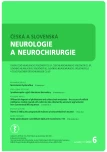Protein S 100B a jeho prognostické možnosti u kraniocerebrálních traumat
Authors:
Š. Trnka; J. Jablonský; P. Stejskal; L. Hrabálek; M. Vaverka; D. Krahulík
Authors‘ workplace:
Neurochirurgická klinika LF UP a FN Olomouc
Published in:
Cesk Slov Neurol N 2021; 84(6): 562-566
Category:
Short Communication
doi:
https://doi.org/10.48095/cccsnn2021562
Overview
Aim: The aim of this study was to explore prognostic capabilities of protein S 100B as a possible biochemical marker in patients with traumatic brain injury. Materials and methods: In this pilot study, we enrolled 22 patients with a traumatic brain injury verified on CT. S 100B levels were measured within 3 h and later on after 8, 12, 24 and 72 h following the trauma. Results: Initial checks of levels within 3 h following the trauma proved to be at a peak median 0.624 (0.166; 1.250) μg/L, and in the following hours the values declined with statistical significance. We proved a significant moderate negative correlation between the values of protein S 100B measured at all time checkpoints with initial Glasgow Coma Scale (GCS) values, with the highest correlation after 72 h. We did not prove any significant dependency of the levels of protein S100B and patient’s age. Higher levels of protein S 100B were found in patients with additional injuries with a median of 1.250 (1.180; 3.380) μg/L compared to patients with isolated traumatic brain injury with a median of 0.438 (0.154; 0.681) μg/L. Patients with unsatisfactory clinical outcome (GCS ≤ 12) on Day 4 were found to have higher levels of protein S 100B after 24 and 72 h. The most reliable cut-off level of protein S 100B for predicting favorable clinical outcome (GCS ≥ 13) on Day 4 was possible after 72 h at the level of ≤ 0.132 μg/L with 94.1% sensitivity and 100% specificity. Conclusion: The study supports the potential prognostic use of serum S 100B protein in patients with with traumatic brain injury.
Keywords:
traumatic brain injury – protein S 100B – CT – Glasgow Coma Scale
Sources
1. Navrátil L. Dekompresivní kraniotomie u kraniocerebrálních poranění – hodnocení přežití a jeho kvality po jednom roce od úrazu. Cesk Slov Neurol N 2007; 70/103 (3): 294–301.
2. Smrčka M, Švestková O, Navrátil O. Kraniocerebrální poranění a možnosti následné rehabilitace – popis problematiky a přehled literatury. Neurol Praxi 2013; 14 (2): 80–83.
3. Přibáň V, Smrčka M. Současná terapie těžkých kraniocerebrálních poranění – souborný referát. Úraz Chir 2009; 17 (3): 68–78.
4. Gudeman SK, Kishore PR, Miller JD et al. The genesis and significance of delayed traumatic intracerebral hematoma. Neurosurgery 1979; 5 (3): 309–313.
5. Lavička P, Pikner R, Kormunda S et al. Význam stanovení S100B proteinu u pacientů s izolovaným poraněním hlavy. Cesk Slov Neurol N 2007; 70/103 (5): 521–526.
6. Haimoto H, Hosoda S, Kato K. Differential distribution of immunoreactive S100-alpha and S100-beta proteins in normal nonnervous human tissues. Lab Invest 1987; 57 (5): 489–498.
7. Ingebrigtsen T, Romner B, Kongstad P et al. Increased serum concentrations of protein S-100 after minor head injury: a biochemical serum marker with prognostic value? J Neurol Neurosurg Psychiatry 1995; 59 (1): 103–104. doi: 10.1136/jnnp.59.1.103-a.
8. Rothermundt M, Peters M, Prehn JH et al. S100B in brain damage and neurodegeneration. Microsc Res Tech 2003; 60 (6): 614–632. doi: 10.1002/jemt.10303.
9. Townend W, Dibble C, Abid K et al. Rapid elimination of protein S-100B from serum after minor head trauma. J Neurotrauma 2006; 23 (2): 149–155. doi: 10.1089/ neu.2006.23.149.
10. Teasdale G, Jennett B. Assessment of coma and impaired consciousness. A practical scale. Lancet 1974; 2 (7872): 81–84. doi: 10.1016/s0140-6736 (74) 91639-0.
11. Blumbergs PC. Pathology. In: Reilly PL, Bullock R (eds). Head injury: pathophysiology and management. London, UK: Hodder Arnold 2005 : 41–72.
12. Herrmann M, Jost S, Kutz S et al. Temporal profile of release of neurobiochemical markers of brain damage after traumatic brain injury is associated with intracranial pathology as demonstrated in cranial computerized tomography. J Neurotrauma 2000; 17 (2): 113–122. doi: 10.1089/neu.2000.17.113.
13. Pikner R, Lavička P, Kormunda S et al. Ověření referenčního intervalu hodnot S100B a NSE – závislosti na věku, době odběru a pohlaví. Klin Biochem Metab 2007; 15 (36): 168–171.
14. Pfortmueller CA, Drexel C, Krähenmann-Müller S et al. S-100 B concentrations are a predictor of decreased survival in patients with major trauma, independently of head injury. PLoS One 2016; 11 (3): e0152822. doi: 10.1371/journal.pone.0152822.
Labels
Paediatric neurology Neurosurgery NeurologyArticle was published in
Czech and Slovak Neurology and Neurosurgery

2021 Issue 6
- Advances in the Treatment of Myasthenia Gravis on the Horizon
- Hope Awakens with Early Diagnosis of Parkinson's Disease Based on Skin Odor
- Metamizole in perioperative treatment in children under 14 years – results of a questionnaire survey from practice
Most read in this issue
- Stiff -person syndrom
- Normotenzní hydrocefalus
- Synukleinopatie a jejich laboratorní biomarkery
- Perorální kladribin v léčbě roztroušené sklerózy – data z celostátního registru ReMuS®
